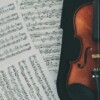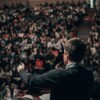Since I was a child, music has been an integral part of my development. In fact, I find it difficult to recall times in my life when music was not omnipresent—from singing in my preschool church choir to contributing my soprano voice to what is now the Houston Boychoir (that is, until being dismissed when God saw it fit for my voice to change) to, later in my youth, accompanying for and assisting in the direction of children’s summer music camps at my home church, music has been both a vehicle through which God enabled my psychosocial development and, more importantly, a vessel through which I have felt most free to express my understanding of, faith in and gratitude to God.
Imagine my surprise, then, when I entered higher education as a student of music and music became an object, an end in and of itself. Though my first two degrees were at church-affiliated institutions, the opus became the central authority, the composer the chief creator, and the performance the ultimate end. As I continued to develop as a conductor, I was challenged to be the “composer’s advocate,” striving to honor the composer’s intentions for the work in preparation for the almighty performance. Though admittedly I still use this term sparingly with my students to this day when discussing issues of performance practice, I found that much was missing from this single-sided approach to conducting choral music. Though He was oftentimes the subject matter of the texts we were to sing, where was God?
I noticed this void most clearly when I began working in my first music ministry position in a local congregation during my undergraduate years. Upon receiving this job, my mother gave me a piece of artwork that I cherish to this day; the framed piece beautifully paraphrases Colossians 3:16: “Let the word of Christ dwell in you richly; teach and admonish one another in all wisdom; and with gratitude in your hearts sing psalms, hymns, and spiritual songs to God.”1 Though I did not understand the far-reaching implications of my realization at the time, it was at this moment, receiving this most meaningful gift, that I began to understand my developing calling to ministry through education. We are called to teach in all wisdom with the word of Christ dwelling within us; there was no reason for the wisdom of Christ and God’s Word to be relegated to the church, separate from the wisdom that was being shared by my professors. Faith and learning, I discovered, must intersect in the academy.
My intention is not to infer that my mentors in higher education were ineffective or secularist. On the contrary, I know through many other contexts that they were all men and women with a strong faith and a personal saving relationship with Christ. They simply had not, as I had not, seen the integration of faith and learning modeled at the secular institutions from which they received their training.2
In my own research, I have discovered a significant dearth of scholarly thought about faith and learning in music, let alone choral music specifically. Jeremy Begbie identifies the root cause of this lacuna: “Thinking Christians may be inclined to disregard music simply because they believe, with many others, that it does not concern anything objective, anything that could invite claims to truth.”3 Though the Bible is replete with references to music and approximately three quarters of these references are to song,4 the Bible is silent on many specifics of music as we might practice it today. However, amidst this relative silence, I propose that the Christian choral educator can adopt what Stephen and Jane Beers call the “foundational authority” model,5 allowing Biblical understanding and a Christian worldview to shape academic and artistic inquiry. Wilkens and Sanford reference the Wesleyan Quadrilateral when addressing matters on which the Bible is silent or lacks specifics, and it is my hope to balance the “intertwined authorities” of Scripture, reason, tradition and experience now and in the future when approaching the intersection of faith and learning in the choral rehearsal.6 Begbie reminds us, “For the follower of Christ, there is no ‘exclusion zone,’ no ‘secular’ territory outside the scope of his saving work, no value-free or neutral area of human life.”7 Choral music is no exception.
The Nature of Music and Musical Study
While a definitive study or a universal definition of music is beyond the scope of this article, a few thoughts on the nature of music and musical study through the lens of a Christian worldview are helpful when embarking on a discussion of the integration of faith and learning in the choral rehearsal. First, music requires time; it is, as Don E. Saliers asserts, “intimately related to the narrative quality of human existence, presenting our temporality in symbolic form, but always bodily perceived through the senses.”8 Begbie fleshes out this idea, writing, “The character of a piece of music is not given in an instant, or even a near-instant, but can be discovered only in and through time, and in some pieces only when it reaches a climactic gathering together, the end toward which it travels.”9 The tensions and resolutions; the recurring themes, developments and episodes; and the ephemeral nature of musical experiences all serve as corollary to the Christian journey. Moreover, the fact that music takes time—significant time in the context of rehearsals—and the reality that time is limited remind the Christian music educator that the content to which we dedicate time in rehearsal matters immensely. Time spent on one piece comes at the cost of time spent on others. Inasmuch as music echoes the nature of our earthly existence, great care must be taken when discerning how musical time is allocated.
Secondly, Saliers goes on to suggest that music “cross[es] over to what is not heard.”10 While it is innately physical and ephemeral in its production and reception, music has the power to transcend physical and temporal limitations. Music does not exist in a vacuum. Begbie reminds us that music is profoundly influenced by the particular state of our minds and bodies, the memories or extra-musical associations we have with a particular piece of music, socio-cultural conventions that influence its performance and reception, and the myriad other elements that are perceived simultaneously as music is heard.11 As inspired as we may be by music, it does not exist alone. Saliers refers to this reality as a synaesthetic matrix, the “simultaneous blending or convergence of two or more senses.”12 As a choir performs Brahms’ Ein deutsches Requiem, one cannot ignore the intensity with which the singers watch the conductor, the synchronized bowing of the first violins or even the concertgoer that has fallen asleep in the second row. All of these are authentic parts of the music-making and -consuming experience.
I challenge you to leave the concert hall for a moment and to think about a song from your childhood. Recalling that song may evoke memories of your friends, of activities, movements, smells coming from the kitchen or even hugs from loved ones departed with whom you shared in the creation of that song. Music has a strong tie to long-term memory far beyond what is heard. It is this power of music that inspires awe when an Alzheimer’s patient may not be able to recall her son’s name but can easily remember the song she sang to him at bedtime when he was a child.13 It is this same power of music that God has gifted us that has fostered the growth of the field of music therapy.14 When the choral educator and students recognize the interconnectedness that music has with other fields and oftentimes far-removed experiences, the journey toward true faith and learning integration can begin.
Thirdly, music, as Begbie eloquently agrees, “is best construed first of all not as an object or objects but as something that is done.”15 In another essay, he expands on this concept: “Put more theologically, there is the beauty directly given to the world by God, and that which we are invited to fashion as God’s creatures.”16 Music is an action, not an object as I was taught during my own higher education experience; it is a process of the creation of a form of beauty gifted to us by our Creator. We must abandon the “tripartite division of composer, performer, and listener”17 in favor of a deference to the creation, redemption and sustaining of the triune God.
Stephen K. Moroney suggests we must “‘reintegrate’ spheres of truth that have been artificially disconnected.”18 Though music and musicians do not typically make truth claims that are either complementary or contradictory to divine revelation, many musical studies in higher education are in constant danger of abandoning the acknowledgment of the Giver of our gifts in the curriculum—essentially a sin of omission. As musical studies in both Christian and secular institutions rely heavily upon modeling, especially in the rehearsal setting, Christian choral conductors have the unique opportunity to model not only vocal technique but also a life of faith in the midst of a musicultural19 context that is otherwise largely secular. Charlotte Y. Kroeker challenges us to remember, “a faculty member’s attention to the coherence of faith and the music profession may be the very best gift we can give our students.”20
Choral Music as Corporate Expression
To offer yet another descriptive definition of music, Saliers writes, “Music is the language of the soul made audible especially as music is the performative mode of the prayer and ritual engagement of a community.”21 He goes on to stress that corporate music making creates a “communal sense of shared narrative.”22 In fact, the Bible offers us significant insight into the corporate nature of singing. The Israelites sang corporately during work and worship,23 and we are reminded that “a great multitude” will be singing in heaven.24 Ephesians 5:18-19 refers to a sort of “two-dimensional song,”25 singing at once “to the Lord” and “among yourselves.” Additionally, I Corinthians 14:26 instructs us that hymns are intended for the “building up” of the community.26
Singing is most often (though not always) a corporate, communal activity.
In fact, it is often this sense of community that conductors tend to ignore when they refer to “my interpretation,” the “composer’s intention” or “historical performance practice.” Though each of these has its time and place, the conductor must not forget that each and every one of her students is made in the image of God. To this end, the choral conductor must intentionally foster a spirit of community within the ensemble27 while not neglecting the need to nurture students individually as they are in the midst of discovering their unique spiritual gifts. Elizabeth O’Connor writes: “To be a person in community one must both give and receive, confirm and be confirmed. The Christian Church comes into being as we come to know our own gifts and help others to know theirs.”28
Recognizing that singing as a community has a basis in the foundational authority of the Scriptures, I strive to offer community-building activities in our ensembles—from a Chorale retreat that focuses not only on music-making but on spiritual formation and the development of interpersonal relationships within the ensemble to Super Bowl parties and other dinner gatherings in our home. Additionally, I practice a technique that music educator Tim Lautzenheiser also espouses, using community-based language (“we-us”) instead of conductor-centered language (“I-me”).29
Selecting Choral Repertoire: You are What You Sing
If the communal aspect of choral singing is of integral importance, then the texts sung by the community must be treated with appropriate seriousness. Referring to congregational hymnody, Saliers states: “Once a hymn text is released musically into the bloodstream of a congregation’s repertoire, it plays a deeply formative role in the shared theology of the assembly.”30 The sobering realization to take from this statement is that you are what you sing. Though university choirs are not a congregation, the texts I choose for them to sing are far from inconsequential—they become a part of the DNA of the community. Additionally, living in the reality of music taking time, choosing one text comes with a tremendous opportunity cost: not singing others. When choosing literature, the choral conductor must consider the theological and pedagogical value that a piece, a text, brings to the community. If its value is questionable, the piece must not be programmed.
Redeeming Secular Music
In a Christian academic setting, the programming of sacred music is welcomed without question, but what is the role of secular music in the faith-learning environment of choral ensembles? To acknowledge a bit of irony, we spend so much time in our methods courses addressing questions from music education students about how to justify the use of sacred music in the public school classroom that we often do not consider the role of secular music in the Christian ensemble. Though many students have questioned me (and, doubtless, will continue to do so) about my inclusion of secular music in many of our programs, I maintain that there is a place for secular music in our faith and learning journey together. Kroeker writes: “I would never want to suggest…that a musician’s life can or should be divided into Christian and non-Christian segments.”31 In a letter to Kroeker, Karen DeMol adds: “The rest of professional musical life is also Christian service, as part of our use of God’s gifts of talent and opportunity to serve others, to serve our culture.”32 David I. Smith refers to Peterson’s reminder that “other ‘serious and good writing’ besides Scripture is ‘intended to change our lives.’”33 This holds true also for secular music.
When programming secular music, we acknowledge that such music can provide for us general revelation and can inform our learning. This allows us to pave a “two-way street” between general and special revelation.34 When approached with a compatibilist integrative strategy,35 secular works give the Christian choral conductor the opportunity to discover with his students harmonies that may exist between Scriptural or sacred texts and secular works. Nicholas Wolterstorff writes, “Education is always and inescapably pointed toward a certain way of being in the world. What is definitive of Christian education is that the teacher leads or guides the student into the Christian way of being in the world.”36 Secular music is a reality in our daily lives and in the vocations to which many of our students are called. In order to fulfill adequately the mission of my university to prepare students to serve “the church, community, and world,” I must not pass on this opportunity to teach students to study secular music Christianly.37
Humility through Choral Performance
In working with choral ensembles at my present institution and elsewhere, I have discovered that such communities offer a unique opportunity to inspire and foster Christian humility. Wilkens and Sanford point out that pride was at the root of the Fall.38 One criticism that many performing artists receive is that they are prideful. Indeed, by virtue of sharing our gifts publicly onstage, are we not elevating the status of our gifts above those of others? Are we not claiming that our interpretation of the music and text is at a high enough level to demand the attention of an audience? By bowing and accepting applause, are we not taking credit for what is God’s alone to claim? In truth, these pitfalls can easily become realities for all performers, causing me to realize the need for humility in the choral rehearsal and performance process.
Rory Noland maintains that pride—boasting in particular—arises out of a performer’s own insecurity.39 In fact, there are a number of factors the can contribute to students’ insecurity in choral ensembles. Kroeker notes that “the one-chance character of live performance can be tremendously stressful.”40 Additionally the omnipresence of nearly perfect, highly produced studio recordings can make even the most exquisitely executed of live performances seem to fall short. A public performance for a university choral ensemble is tantamount to displaying your students’ final exam essays online for all to see. The vulnerability inherent in live performance can lead many to insecurities that give rise to pride.
In order to adopt a Christ-like sense of humility and servanthood, the conductor must address the issue head-on through the aforementioned power of modeling and through formative conversations within the community of singers. Moroney, Phillips and Waalkes call for us to avoid pride by understanding and acknowledging our limitations.41 In doing so we remove the barrier that exists when we “put all our confidence in our giftedness, our natural talent.”42 “Our confidence,” Noland challenges, “is not in our talent but in the power of God to use us in our weakness.”43 True humility in performance, then, is not elevating ourselves to a level that is greater (or lesser) than we are.
A first lesson in humility turns us back to the conversation about the communal nature of choral ensembles. If community has been successfully fostered in the choral ensemble and every member acknowledges that the others are each made in the image of God, they will learn to approach one another with humility, for, as Moroney, Phelps and Waalkes remind us, “they [each] reflect a portion of the image of God.”44 Noland offers us one example of how we might approach such interpersonal humility with our students—we must learn “how to receive a compliment with grace.”45 Following public performances, students are often inundated with praise and find themselves unable to respond appropriately. It is incumbent upon the choral director to guide them in learning how to respond in such settings—without pride but with gratitude for the thoughtfulness of the person offering the compliment. We cannot allow music preparation to crowd out the need for the prayerful reception of positive feedback.
In addition to our call to humble ourselves before one another,46 we must also humble ourselves before God.47 Noland challenges us to perform for an “audience of one,”48 using our art as a created offering to the one true Creator. O’Connor sums up this calling most eloquently: “Our gifts are on loan. We are responsible for spending them in the world, and we will be held accountable.”49 If we work within ourselves and with our students to acknowledge that we are stewards of God’s beautiful gift of music, we will be freed to serve Him and one another through our collaborative creating. If, however, we allow ourselves to be overcome with insecurity or pride, music will once again become an object, an unfulfilling end in and of itself.
Choral Music as Bridge Across the Liberal Arts
I have dedicated the bulk of this article to discovering the overarching themes necessary to approach the integration of faith and learning in the choral rehearsal. In this brief section, I hope to summarize some of the more practical ideas for faith-learning integration that I have come across in my research and experience.
Learning in Music
Lisa M. Hess acknowledges the need for us to move from the perspective of “learning from music” to “learning in music.”50 In this vein, we must not forget the opportunity that we have in choral ensembles to establish an environment in which learning in the music can take place. Rather than approaching a piece of music for music’s sake, conductors should challenge their students to dig into the depths of how the repertoire relates to other courses they have taken in the liberal arts. How does a Bach chorale relate to the Reformation discussion the students had in history class? How can students use the language skills they have gained in an American Sign Language classes to enhance our corporate communication? How does a traditional spiritual speak to the overarching themes encountered in our African American Literature and Culture course? The possibilities for integration across the curriculum are endless; it simply takes the additional investment of knowing what your students have been and are studying in other departments.
Practical Significance
Many university ensembles across the country perform only literature that no undergraduate student could hope to conduct in their first teaching, community or ministry job. It is imperative that the choral conductor not only challenge the students to grow in music that is considerably challenging at a collegiate level, but she must also expose students to well-performed, accessible literature that can help them to “develop awareness of how such literature and ensembles could serve the Church”51 here many of our students will find themselves teaching. We must afford the students opportunities to experience music that they soon may find themselves conducting in their vocations and ministries.
Interdisciplinary Study
Kroeker proposes an interdisciplinary approach, for example, to the study of a major choral-orchestral works.52 Rather than limiting integration to the choral rehearsal, she challenges us to approach the preparation of a work across the curriculum intentionally. While we prepare the work in choral rehearsals, the theology department dedicates some time, for example, to the text and hermeneutics, while the history department sets aside a class to discuss the historical context and the art department surveys contemporaneous developments in the visual arts. Though seemingly far-fetched, what an amazing collaborative effort across the curriculum this could be! The compatibilist two-way street would expand into a multi-lane superhighway of integrative discovery.
Integrative Questions
Beers and Beers emphasized the importance of Harold Heie’s concept of integrative questions.53 Integrative questions should occupy a central place in the choral rehearsal. Samples of such questions include:
- From your reading of Revelation, how would youset the Diesiraetext to music?
- Imagine that Christ is sitting in the front row of the audience. How would he respond to our concert?
- How does this secular text inform your understanding of the nature of God’s creation?
Lautzenheiser acknowledges the power of questions in music education: “Suppose quality music education is based on an infinite journey of questions? If so, then the process of learning becomes the focal point instead of some elusive destination… The joy of teaching lies in this endless expedition.” 54
Conclusion
Musical phenomena have the potential…to open willing participants to new insights and levels of awareness, unhinged from previous anticipations or intended objectives in a teaching/learning environment. 55
Lisa Hess’ statement above acknowledges the uniqueness of and the power behind the gift God has given us in music. In my own teaching, I prayerfully strive to remember the implications of the decisions I make that impact community, our shared narrative through literature, our humility through performance and an intentional interdisciplinary integration, as each of these is essential to the integration of faith and learning in the choral rehearsal. While I recognize that my Christian worldview should and will undergo continual reevaluation and revision, I readily embrace the “ongoing journey”56 that is inherent in my commitment to serve God, my institution and my students faithfully. Though I have been pondering the integration of faith and learning since my own days as an undergraduate, I look forward to continuing to do so for the remainder of my career.
Endnote
In “Faith and Learning in the Choral Rehearsal,” Jon C. Peterson draws from his own educational journey, scripture and existing scholarship to investigate faith-learning integration for choral music faculty in Christian liberal arts institutions. This first-person essay discusses the nature of music and musical training and offers examples of how Christian educators can grow beyond the modeling many have experienced at secular institutions. In the end, it is intended to serve as a catalyst for further research, introspection and discussion about meaningful ways to approach work with choral ensembles from a distinctly Christian perspective.
Cite this article
Footnotes
- Col. 3:16 (New Revised Standard Version).
- Many Christian scholars recognize the fact that our formal training has taken place primarily at secular institutions. See, for example, Stephen Beers and Jane Beers, “Integration of Faith and Learning,” in The Soul of a Christian University: A Field Guide for Educators, ed. Stephen T. Beers (Abilene, TX: Abilene Christian University Press, 2008), 52; Stephen Moroney, “Where Faith and Learning Intersect: Re-Mapping the Contemporary Terrain,” Christian Scholar’s Review 43.2 (Winter 2014): 141; Charlotte Y. Kroeker, “Music Pedagogy and the Christian Faith: A Twenty-Year Journey of Discovery,” in Teaching as an Act of Faith, ed. Arlin C. Migliazzo (New York: Fordham University Press, 2002), 217.
- Jeremy Begbie, Resounding Truth: Christian Wisdom in the World of Music (Grand Rapids: Baker Academic, 2007), 14.
- Ibid., 61.
- Beers, 59.
- Steve Wilkens and Mark L. Sanford, Hidden Worldviews: Eight Cultural Stories That Shape Our Lives (Downers Grove, IL: IVP Academic, 2009), 210.
- Begbie, Resounding Truth, 15.
- Don E. Saliers, Music and Theology (Nashville: Abingdon Press, 2007), 7.
- Begbie, Resounding Truth, 220.
- Saliers, 8.
- Begbie, Resounding Truth, 54-55.
- Saliers, 1.
- Saliers discusses the associated power of music with memory in Ibid., 4-6.
- I have been most profoundly impacted by the power of music therapy in the rehabilitation of retired Congresswoman Gabrielle Giffords following a gunshot wound to the head. (Giffords began serving in Arizona’s 8th congressional district during my doctoral studies in Tucson.) During her recovery, doctors and music therapists discovered that she was able to communicate through singing more thoroughly and accurately before she was able to do so through the spoken word.
- Begbie, Resounding Truth, 39.
- Jeremy S. Begbie, “Created Beauty: The Witness of J.S. Bach,” in The Beauty of God: Theology and the Arts, eds. Daniel J. Tereier, Mark Husbands and Roger Lundin (Downers Grove, IL: IVP Academic, 2007), 19.
- Begbie, Resounding Truth.
- Moroney.
- Musiculture is a term used by some ethnomusicologists to signify the fact that musical and cultural practices are inextricably linked.
- Kroeker, 212.
- Saliers, 4.
- Ibid., 5.
- Num. 21:16-18
- Rev. 19:1-8 (NRSV).
- Begbie, Resounding Truth, 70.
- Ibid.
- Kroeker, 223.
- Elizabeth O’Connor, Eighth Day of Creation: Gifts and Creativity (Waco, TX: Word Books, 1971), 20.
- Tim Lautzenheiser, The Joy of Inspired Teaching (Chicago: GIA Publications, 1993), 141.
- Saliers, 39-40.
- Kroeker, 220.
- Ibid.
- David I. Smith, “Reading Practices and Christian Pedagogy: Enacting Charity with Texts,” in Teaching and Christian Practices: Reshaping Faith and Learning, eds. David I. Smith and James K. A. Smith (Grand Rapids: William B. Eerdmans Publishing Company, 2011), 45.
- Beers, 62.
- Ibid., 63.
- Nicholas P. Wolterstorff, Educating for Life: Reflections on Christian Teaching and Learning (Grand Rapids: Baker Academic, 2002), 106.
- Naturally, there will occasionally be literature that is antithetical to the Christian faith and institutional mission. In such cases, the two-way street must come to a halt in favor of divine revelation.
- Wilkens and Sanford, 189.
- Rory Noland, The Heart of the Artist: A Character-Building Guide for You & Your Ministry Team (Grand Rapids: Zondervan, 1999), 55.
- Kroeker, 214.
- Stephen K. Moroney, Matthew P. Phelps and Scott T. Waalkes, “Cultivating Humility: Teaching Practices Rooted in Christian Anthropology,” in The Schooled Heart: Moral Formation in American Higher Education, eds. Michael D. Beaty and Douglas V. Henry (Waco, TX: Baylor University Press, 2007), 178.
- Noland.
- Ibid., 56.
- Moroney, Phelps and Waalkes, 174.
- Noland, 60.
- See I Peter 5:5.
- See Deut. 8:17-18 and I Cor. 15:10.
- Noland, 74.
- O’Connor, 15.
- Lisa M. Hess, Learning in a Musical Key: Insight for Theology in Performative Mode(Eugene, OR: Pickwick Publications, 2011), 167.
- Kroeker, 223.
- See, for example, Ibid., 225-227.
- See, for example, Beers, 69-70.
- Lautzenheiser, 28.
- Hess, 167.
- Wilkens and Sanford, 206.























